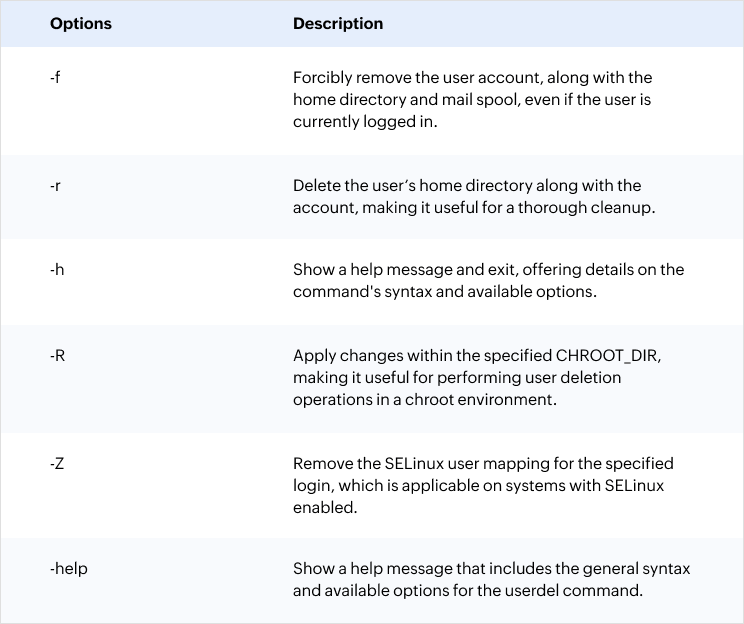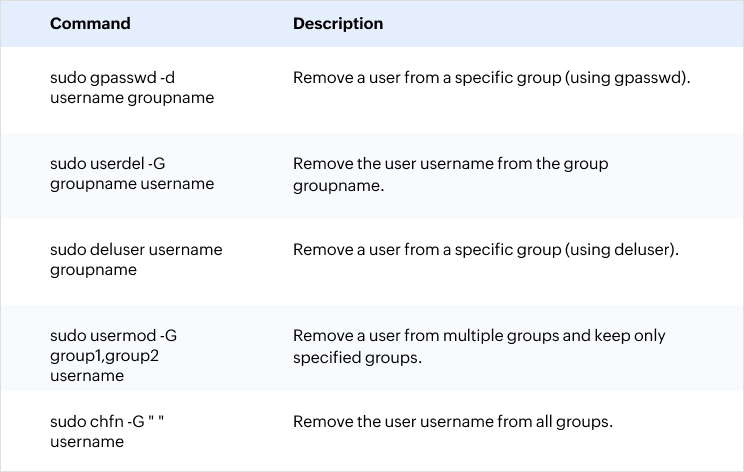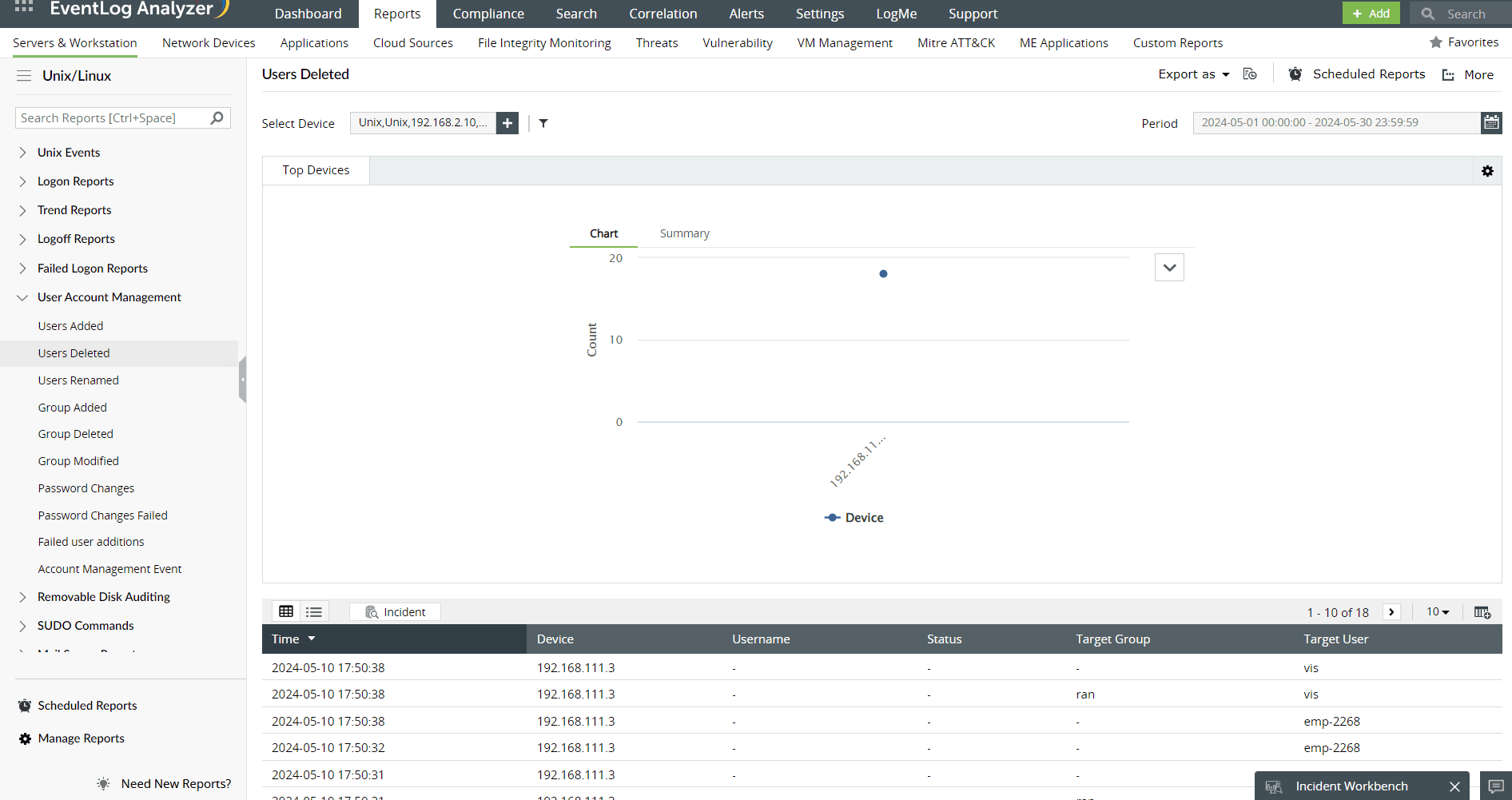Linux
- Home
- Logging Guide
- How to remove a user in Linux
How to remove a user in Linux
On this page
- How to use the userdel command to delete a user in Linux
- How to remove users from groups in Linux
- Best practices while deleting users in Linux
- How ManageEngine EventLog Analyzer aids in monitoring Linux user activitie
User account management is a fundamental aspect of Linux system administration. It involves creating, assigning, and managing user accounts to ensure proper access and control within the system. One crucial task in this process is the removal of user accounts when they are no longer needed or when a user leaves the organization. Deleting a user account effectively revokes their access to the system, removes unused resources, and helps maintain system security.
The userdel command is a powerful tool designed for this purpose. It allows system administrators to remove user accounts efficiently along with their associated home directories and permissions. When deleting a user account, it's essential to consider both the removal of the user from the system itself and the removal of their membership from any relevant groups. By understanding how to use the userdel command and its associated options, administrators can effectively manage user accounts and ensure the integrity of their Linux systems.
Prerequisites:
- Root privileges: You'll need to be logged in as the root user or have sudo privileges to execute the commands.
- Identification of the user: Know the username of the user you want to delete.
How to use the userdel command to delete a user in Linux
The userdel command in Linux is used to delete a user account and its associated files. It modifies the system account files by removing all entries related to the specified username (LOGIN). As a low-level utility, userdel is a core tool for removing users from the system. It is part of the standard user management toolkit, alongside commands like useradd and usermod. In addition to deleting the user account, userdel can also handle related files, such as the user's home directory and mail spool, ensuring a thorough cleanup.
The syntax for the userdel command is as follows:
userdel [options] username
Here,
- options: Additional command options that modify how the user deletion is performed
- username: The username of the account to be deleted
Below are some commonly used options for the userdel command:

How to remove users from groups in Linux

Kindly refer to the page on how to add a user to a group in Linux for detailed guidance on adding, deleting, viewing, and listing users in groups; creating and deleting groups in Linux; and more.
Best practices while deleting users in Linux
- Regularly review user accounts: Regularly reviewing user accounts enhances security and organization by identifying inactive accounts that may pose risks if left unchecked. It ensures only active, authorized users have access, preventing potential unauthorized access and minimizing disruptions from overlooked, inactive accounts.
- Evaluate the need for deletion: Evaluate if the account should be temporarily disabled or permanently deleted. If the user is temporarily inactive or on leave, consider disabling the account instead of deleting it.
- Document the deletion: Keep records of user deletions for compliance and auditing purposes.
How ManageEngine EventLog Analyzer aids in monitoring user activities in Linux
ManageEngine EventLog Analyzer is a comprehensive log management solution designed to centralize and analyze logs from various sources, including Linux systems. It provides a platform for monitoring user activity and auditing user account changes, including deletions. By consolidating log data, EventLog Analyzer offers real-time insights into user management activities, such as account modifications, and file integrity monitoring. This level of visibility helps administrators effectively track and audit user accounts while ensuring compliance with internal policies and regulatory requirements.
EventLog Analyzer empowers administrators to effectively manage and delete user accounts in Linux environments. By centralizing log data, the solution enables comprehensive monitoring of user activities, including account creation, modification, and deletion.
Key features for user account management:
- User deletion reports: Generate detailed reports on user deletions, including the date, time, and user who performed the deletion.
- Real-time alerts: Receive immediate alerts for unusual user deletion activities, such as mass deletions or deletions during off-hours.
- User activity monitoring: Track user logins, logouts, and system interactions to identify suspicious behavior and potential security threats.
By leveraging these capabilities, you can:
- Enhance security: Proactively identify and respond to security threats related to user account management.
- Streamline processes: Automate the process of user account deletion and reporting.
- Ensure compliance: Adhere to security policies and regulatory requirements by tracking user activities and enforcing access controls.
With EventLog Analyzer, administrators can confidently manage user accounts, mitigate risks, and maintain a secure Linux environment.













